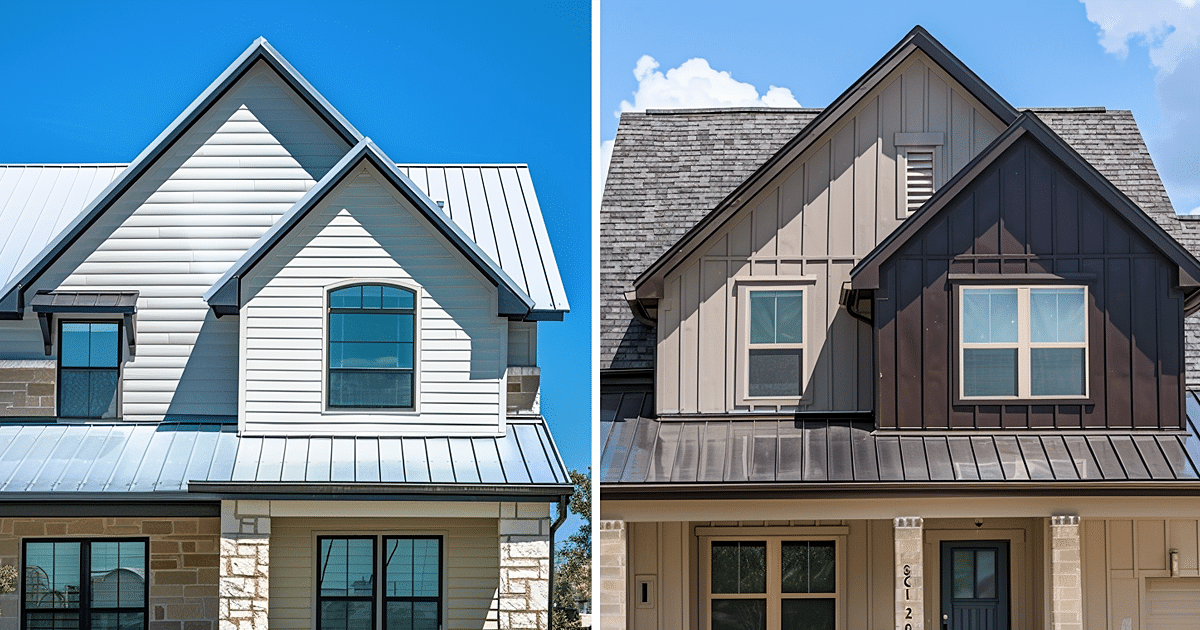When it comes to protecting your most valuable investment, the roofing material you choose can make or break your budget for decades to come. With metal roofs lasting 40-70 years compared to asphalt shingles’ 15-30 year lifespan, this decision impacts far more than just your home’s curb appeal. The metal roof vs shingles debate centers on balancing upfront costs against long-term value, durability against affordability, and performance against practicality.
Over 80% of American homes currently feature asphalt shingle roofs, making them the traditional choice. However, metal roofing has gained significant ground in recent years, particularly in regions prone to extreme weather conditions. This comprehensive guide breaks down everything you need to know about both roofing materials, from initial installation costs to long-term maintenance requirements, helping you make an informed decision that aligns with your budget, climate, and housing goals.
Choose the Right Roofing Material for Your Needs
The fundamental difference between these roofing materials lies in their approach to protecting your home. Metal roofing delivers exceptional longevity, with lifespans ranging from 40 to 70 years and warranties typically covering 30 to 50 years. Premium metal roofing materials like copper or zinc can even exceed 100 years with proper maintenance. In contrast, traditional asphalt shingles generally last 15 to 30 years, with architectural varieties performing better than basic three-tab options.
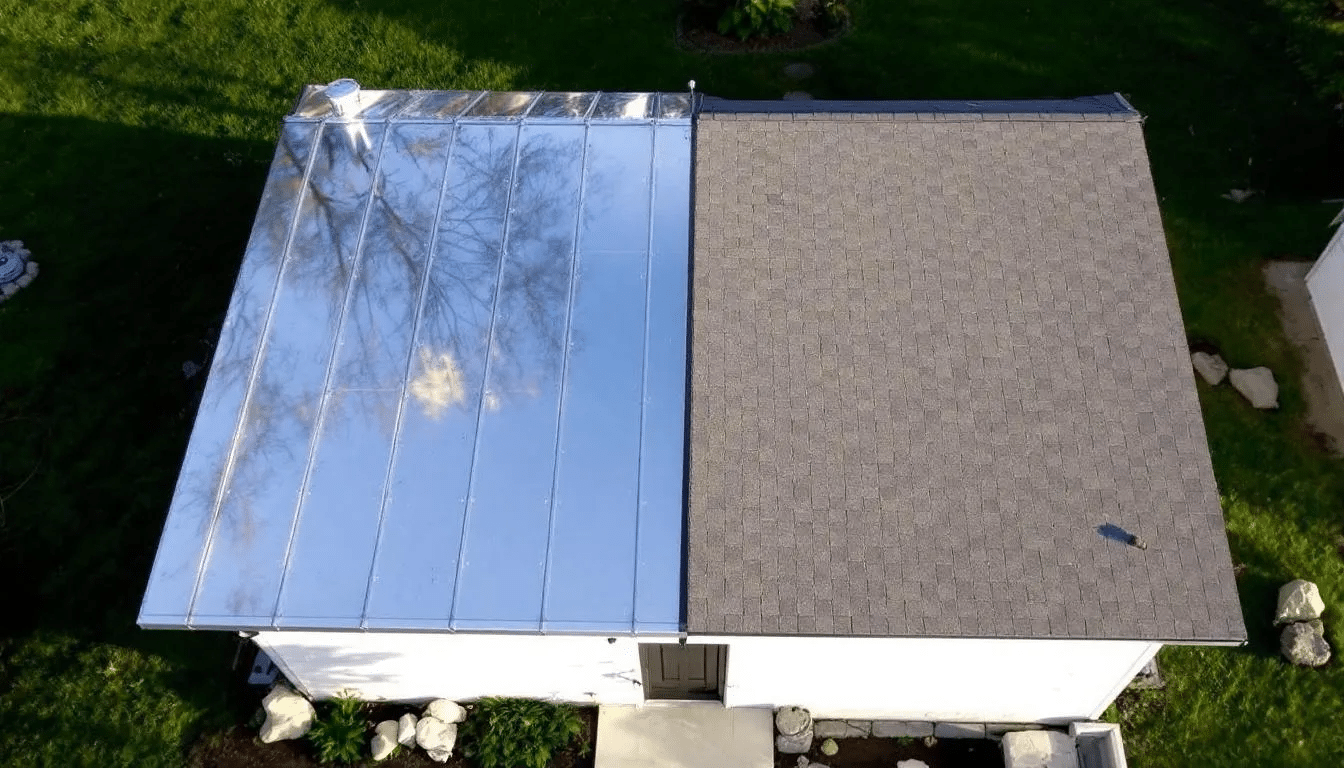
Cost considerations reveal a complex picture. Asphalt shingles cost between $3.50 and $5.50 per square foot for materials, making complete roof replacement on an average home range from $5,800 to $12,200. Metal roofing materials span a much wider price range, from $4 to $30 per square foot depending on the metal type and profile chosen. Total installation costs for metal roofing typically run $15,000 to $24,500 for a standard 1,500-square-foot home.
Performance across different weather conditions showcases where each material excels. Metal roofs demonstrate superior resistance to wind, hail, and fire while reflecting solar heat to reduce cooling costs by 10-25% in hot climates. Asphalt shingle roofs perform adequately in moderate weather but prove more vulnerable to storm damage, ice dams, and heat absorption that increases energy bills.
The decision ultimately hinges on your specific situation. If you prioritize lower upfront costs and plan to own your home for less than 20 years, asphalt shingles offer practical value. For homeowners focused on long-term investment, superior weather protection, and minimal maintenance, metal roofing justifies its higher initial expense through decades of reliable performance.
What Makes These Roofing Materials Unique?
Metal Roofing – Superior Durability and Performance
Metal roofing encompasses several distinct materials, each offering unique advantages. Steel remains the most popular choice for residential applications, often featuring protective coatings like Galvalume (zinc and aluminum alloy) for enhanced corrosion resistance. Aluminum excels in coastal environments due to its natural rust resistance, while copper represents the premium option with its distinctive patina development and century-plus lifespan. Zinc rounds out the high-end options, developing a self-healing patina that provides exceptional longevity.
The variety of metal roofing profiles allows homeowners to achieve different aesthetic goals. Standing seam metal roofs feature interlocking vertical panels with concealed fasteners, creating clean lines prized for both leak resistance and modern appeal. Corrugated metal panels offer economical installation and increasingly appear in contemporary architectural designs. Metal shingles provide the durability benefits of metal while mimicking traditional materials like slate, tile, or wood shakes.
Fire resistance stands as one of metal roofing’s most compelling safety features. Most metal roofing systems achieve a Class A fire rating, the highest available designation. This becomes particularly valuable in wildfire-prone regions where ember resistance can mean the difference between survival and total loss.
Energy efficiency represents another significant advantage of metal roofing. The naturally reflective surface reduces solar heat gain, and specialized cool roof coatings can further enhance this effect. These properties often qualify homeowners for utility rebates and may contribute to LEED certification for environmentally conscious builders.
Environmental sustainability adds another layer of appeal to metal roofing materials. Most metal roofs contain 25-95% recycled content and remain 100% recyclable at the end of their service life. This contrasts sharply with asphalt shingles, which typically end up in landfills after replacement.
Asphalt Shingles – Affordable Traditional Choice
Asphalt shingle roofing divides into two primary categories that serve different needs and budgets. Three-tab shingles provide the most economical option, featuring a single flat layer with uniform appearance. Architectural shingles, also called dimensional shingles, offer enhanced durability through multiple layers that create depth and texture while providing superior wind resistance.
The construction of asphalt shingles centers on a fiberglass mat core, coated with asphalt and finished with ceramic granules that provide UV protection and color. This relatively simple composition allows for extensive customization in colors and textures, enabling homeowners to achieve looks that mimic more expensive materials like slate, wood, or clay tile at a fraction of the cost.
Installation advantages make asphalt shingle roofing particularly attractive for many homeowners. The process requires only basic tools and techniques familiar to virtually every roofing contractor in the United States. This widespread expertise ensures competitive pricing and readily available service for both initial installation and future repairs.
Repair flexibility offers another practical advantage of shingle roofing. Individual damaged shingles can be replaced without affecting surrounding areas, making small repairs quick and inexpensive. This modularity contrasts with some metal roofing systems where panel damage might require more extensive repair work.
The dominance of asphalt shingles in the U.S. market – covering approximately 80% of homes – creates a self-reinforcing cycle of familiarity, contractor expertise, and neighborhood aesthetic compatibility that many homeowners find reassuring.
Metal Roof vs Shingles: Direct Performance Comparison
Lifespan and Durability
The longevity gap between metal roofs and asphalt shingles represents one of the most significant factors in the roofing material decision. Metal roofing systems typically deliver 40 to 70 years of service life, with manufacturer warranties often spanning 30 to 50 years. Premium metal roofing products may even exceed these timeframes, particularly copper and zinc installations that can last over a century with proper maintenance.
Asphalt shingle roofs, while reliable within their intended lifespan, generally require replacement every 15 to 30 years. Basic three-tab shingles trend toward the shorter end of this range, while higher-quality architectural shingles approach the upper limit. Several factors contribute to shingle degradation over time, including granule loss, cracking from thermal cycling, and susceptibility to biological growth like algae and moss.
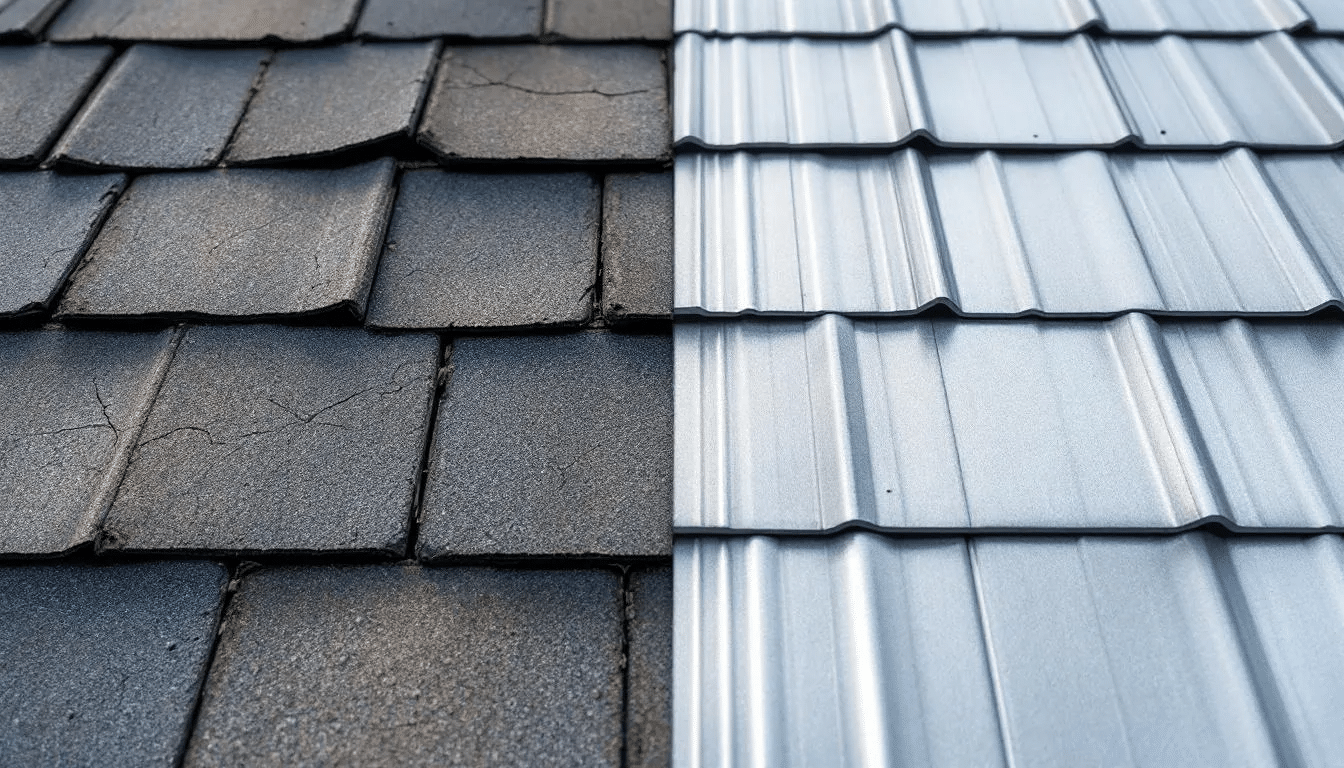
Extreme weather events highlight the durability differences between these roofing materials. Metal roofs maintain structural integrity and weather resistance even when subjected to large hail, with denting typically being cosmetic rather than functional damage. Asphalt shingles may crack, split, or lose protective granules when impacted by hail, potentially compromising the roof system’s water resistance.
The cumulative effect of these durability differences becomes apparent when considering total cost of ownership. Over a 50-year period, homeowners might replace an asphalt shingle roof two to three times, while a single metal roof installation could last the entire duration.
Installation and Maintenance
Metal roof installation demands specialized knowledge and precise execution to achieve optimal performance. Proper alignment of panels, correct fastener placement, and appropriate flashing details require experienced contractors familiar with metal roofing systems. Installation errors can lead to premature leaks, thermal movement issues, or reduced wind resistance, making contractor selection crucial for metal roofing projects.
Asphalt shingle installation follows more straightforward procedures that most roofing contractors can execute competently. The process uses familiar tools and techniques, allowing for faster installation and broader contractor availability. This accessibility translates to competitive pricing and shorter project timelines for shingle roofing.
Maintenance requirements differ substantially between these roofing materials. Metal roofs typically need minimal maintenance, consisting primarily of periodic visual inspections and occasional cleaning with soap and water. The durable surface resists biological growth and maintains its appearance with little intervention.
Shingle roofs require more active maintenance to maximize their lifespan. Regular inspections help identify loose, damaged, or missing shingles that need replacement. Homeowners must also monitor for granule loss, which accelerates aging and reduces UV protection. Additionally, shingle roofs may develop issues with algae growth or ice dams that require specific treatment or prevention strategies.
Weather Resistance
Weather performance represents a critical differentiator in the metal roof vs shingles comparison, particularly for homes in challenging climates. Metal roofing systems excel in high-wind conditions, with many products tested to withstand winds up to 140 mph or higher. The interlocking design of standing seam metal roofs provides exceptional resistance to wind uplift, while the non-combustible nature of metal materials earns the highest Class A fire rating.
Asphalt shingle roofs offer adequate wind resistance for most applications, with premium architectural shingles rated for winds up to 110 mph. However, basic three-tab shingles may perform poorly in high-wind events, and the Class C fire rating of most asphalt shingles provides less protection than metal alternatives.
Hail resistance showcases another performance difference between these materials. Metal roofing may dent when struck by large hail but typically maintains its water-shedding capability. The structural integrity of the roof system remains intact, though cosmetic damage may occur. Asphalt shingles can crack or lose granules when impacted by hail, potentially creating entry points for water infiltration.
Snow and ice present additional challenges where metal roofing often outperforms asphalt shingles. The smooth surface of metal roofs allows snow to slide off naturally, reducing structural loads and minimizing ice dam formation. Asphalt shingles provide more friction for snow retention and may be more susceptible to ice dam damage in cold climates.
Cost Analysis: Initial Investment vs Long-Term Value
Upfront Costs
The initial financial investment for roofing materials reveals significant differences between metal and asphalt options. Asphalt shingle roofing materials typically cost $3.50 to $5.50 per square foot, with total installation projects for average homes ranging from $5,000 to $10,000. Labor costs remain relatively modest due to the straightforward installation process and widespread contractor familiarity with shingle roofing.
Metal roofing presents a much wider cost spectrum, with materials ranging from $4 to $30 per square foot depending on the metal type and profile selected. Standing seam systems and premium metals like copper or zinc command the highest prices, while corrugated steel panels offer more economical entry points into metal roofing. Total installed costs for metal roofing typically range from $10,000 to $25,000 for standard residential applications.
Installation costs for metal roofing run higher than asphalt shingles due to the specialized skills required and longer installation time. Labor costs may range from $300 to $500 per 100 square feet for metal roofing compared to $200 to $300 for asphalt shingles. Additionally, metal roofing material costs can fluctuate with global commodity markets, potentially affecting project budgets during planning phases.
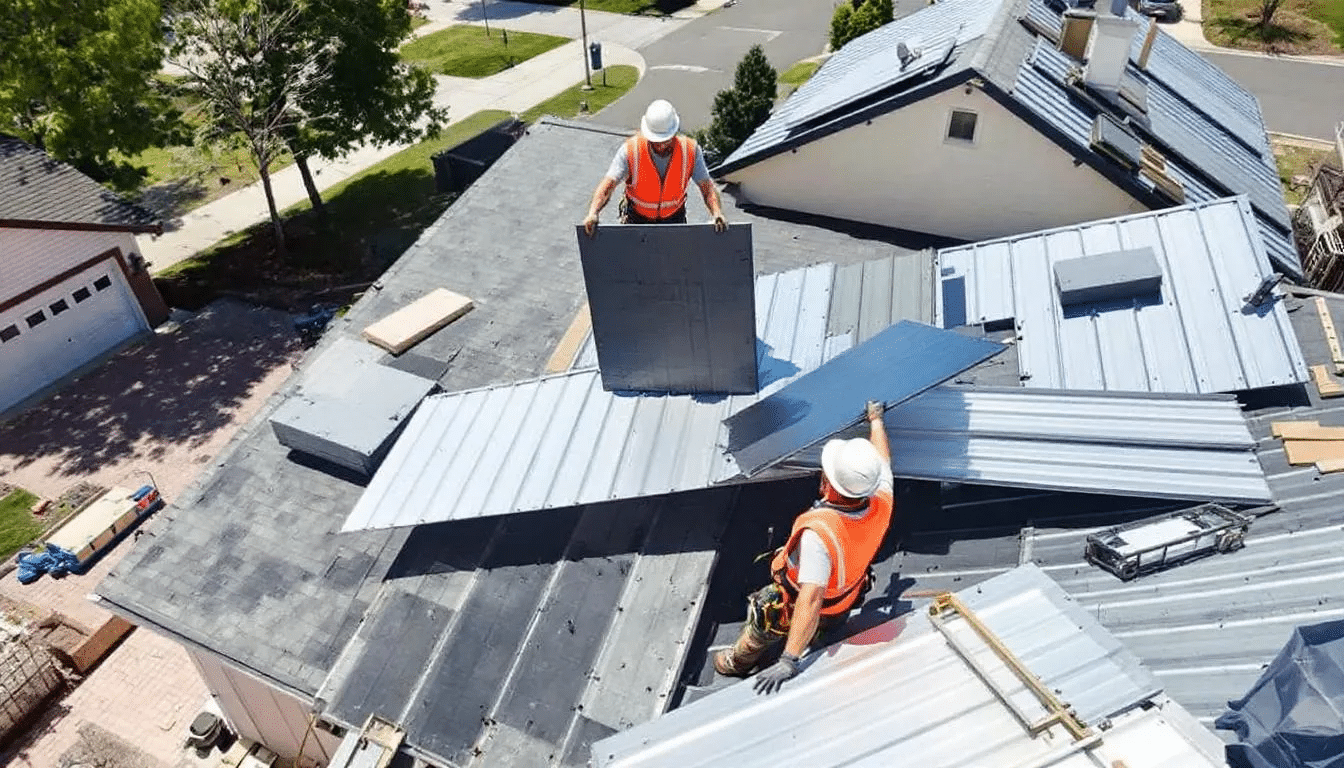
Several factors can increase installation costs for both materials. Complex roof designs with multiple angles, dormers, or penetrations require additional labor and materials regardless of the roofing type chosen. However, these complexities often impact metal roofing costs more significantly due to the precision required for proper installation.
Long-Term Financial Impact
The true cost comparison between metal roof vs shingles emerges when analyzing long-term ownership expenses. While metal roofing requires substantially higher upfront investment, its extended lifespan often provides superior value over time. A homeowner might need to replace asphalt shingle roofs two to three times during the service life of a single metal roof, making the lifetime cost equation favor metal roofing in many scenarios.
Insurance considerations add another financial dimension to the roofing material decision. Many insurance companies offer discounts for metal roofing due to its superior fire and weather resistance. These premium reductions can partially offset the higher initial cost while providing ongoing savings throughout the roof’s lifespan.
Energy efficiency benefits provide additional long-term value for metal roofing. The reflective properties of metal roofs can reduce cooling costs by 10-25% in hot climates, translating to hundreds of dollars in annual savings for many homeowners. Some utility companies offer rebates for cool roof installations, further enhancing the financial benefits of metal roofing.
Property value impacts also favor metal roofing in many markets. Real estate studies indicate that homes with metal roofs often command slightly higher selling prices and may appeal to environmentally conscious buyers. The “premium” perception of metal roofing can differentiate homes in competitive markets.
Tax incentives occasionally become available for energy-efficient roofing materials, including certain metal roofing products that qualify for federal or local credits. These incentives can provide additional financial benefits that improve the overall return on investment for metal roofing projects.
Key Factors to Consider for Your Decision
Your Budget and Timeline
Budget constraints often drive the initial decision between metal roof vs shingles, but smart homeowners look beyond upfront costs to evaluate total ownership expenses. If immediate cash flow concerns limit your roofing budget, asphalt shingles provide reliable protection at accessible price points. The lower initial investment and faster installation timeline make shingle roofing attractive for urgent replacement situations or tight budgets.
However, homeowners planning to stay in their homes for more than 20 years should carefully consider the lifetime cost equation. While metal roofing requires significantly higher upfront investment, the extended lifespan and reduced maintenance needs often provide superior long-term value. The key lies in honest assessment of your housing timeline and financial priorities.
Financing options can help bridge the gap between desired performance and available budget. Many roofing contractors offer financing programs for larger projects, and home equity loans or lines of credit may provide favorable terms for major home improvements like roof replacement. Some homeowners choose to invest in metal roofing as part of broader home renovation projects where the cumulative value justifies the expense.
The timing of your roofing project also influences material selection. Emergency replacements due to storm damage often favor asphalt shingles due to faster installation and broader contractor availability. Planned replacements allow more time to evaluate options, obtain multiple quotes, and potentially schedule work during favorable weather conditions that benefit metal roof installation.
Your Home’s Design and Structure
Architectural compatibility plays a crucial role in roofing material selection, as different materials complement various home styles and design elements. Traditional architectural styles often pair naturally with asphalt shingles, which can mimic higher-end materials like slate or wood at affordable prices. The extensive color and texture options available in asphalt shingles provide flexibility to match existing design elements or achieve specific aesthetic goals.
Modern and contemporary home designs frequently showcase metal roofing as a design feature rather than simply a protective element. Standing seam metal roofs create clean, linear aesthetics that complement minimalist architectural approaches. The variety of metal roofing profiles allows integration with both traditional and contemporary design schemes.
Roof pitch and complexity significantly impact installation feasibility and costs for both materials. Metal roofing can be installed on lower pitch roofs (down to 2:12 slope with appropriate panel types), while asphalt shingles typically require steeper pitches (4:12 or greater) for proper water drainage. Complex roof designs with multiple angles, valleys, and penetrations increase installation complexity and costs for both materials, though metal roofing often requires more specialized detailing.
Structural considerations also influence material selection. Metal roofing weighs significantly less than asphalt shingles (1-3 pounds per square foot versus 2-4 pounds), potentially allowing installation over existing roofing in some cases or reducing structural requirements for new construction. However, the existing roof deck condition must be evaluated to ensure adequate support for either material.
Your Local Climate Conditions
Regional climate patterns strongly influence the relative performance advantages of different roofing materials. Hurricane-prone coastal areas benefit significantly from metal roofing’s superior wind resistance, with many products tested to withstand winds exceeding 140 mph. The non-corrosive properties of aluminum metal roofing make it particularly suitable for salt air environments where traditional materials may deteriorate more rapidly.
Wildfire-prone regions increasingly favor metal roofing due to its Class A fire rating and ember resistance. The non-combustible nature of metal roofing materials provides critical protection in areas prone to falling branches and wind-driven embers. Some insurance companies require or strongly incentivize fire-resistant roofing materials in high-risk wildfire zones.
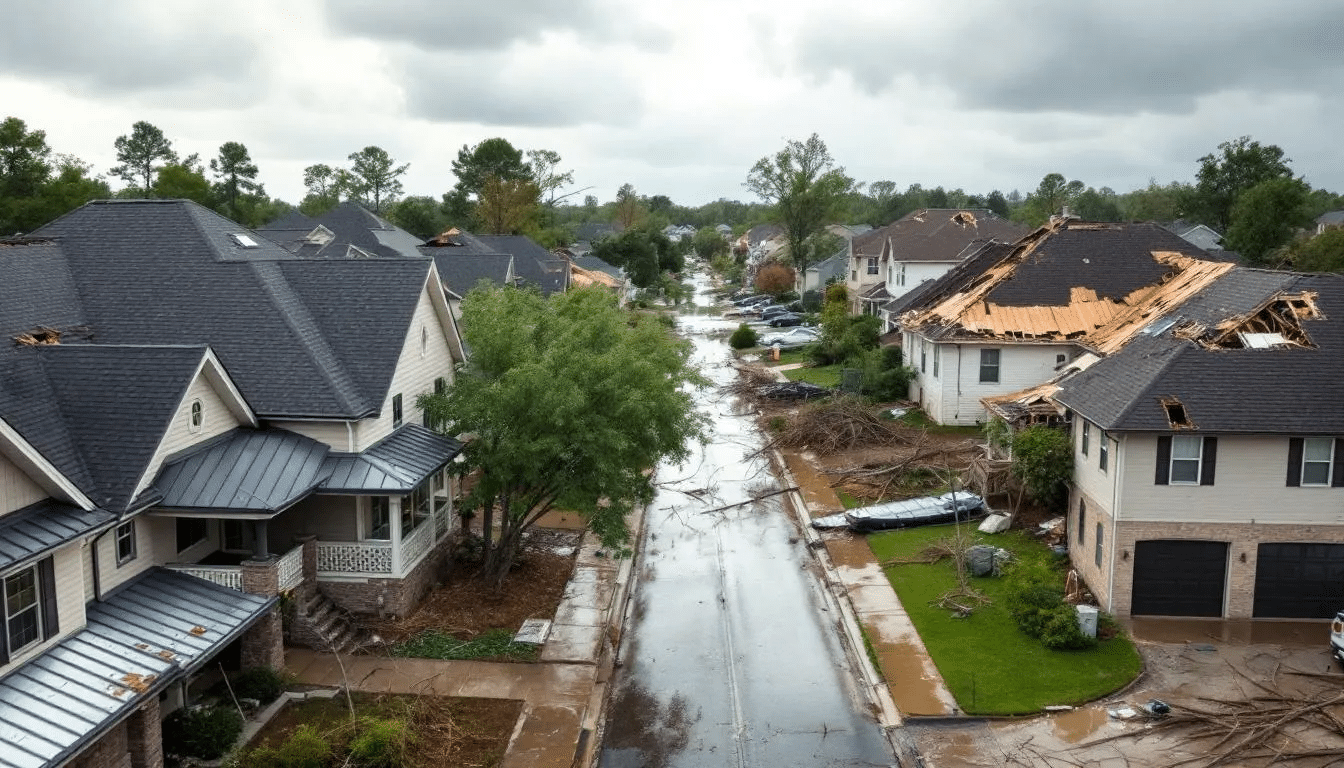
Hail-prone areas present complex considerations for roofing material selection. While metal roofs may dent from large hail impacts, they typically maintain structural integrity and water resistance. Impact-resistant asphalt shingles are available for hail-prone regions, though they command premium pricing and may not provide the same level of protection as metal alternatives.
Cold climate considerations include ice dam prevention and snow load management. Metal roofing’s smooth surface promotes natural snow shedding and reduces ice dam formation, while asphalt shingles may retain snow and be more susceptible to ice dam damage. However, proper insulation and ventilation remain critical regardless of roofing material choice.
HOA and Municipal Restrictions
Homeowners’ association guidelines and local building codes can significantly constrain roofing material choices, making early verification essential before making decisions. Many established neighborhoods maintain aesthetic guidelines that favor traditional roofing materials, potentially restricting or prohibiting certain metal roofing profiles or colors. Some HOAs explicitly prohibit exposed fastener metal roofing or require architectural review approval for metal roofing installations.
Municipal building codes typically address fire ratings, wind resistance, and structural requirements that may favor one material over another. Areas with strict fire codes increasingly require Class A rated roofing materials, giving metal roofing advantages over standard asphalt shingles. Wind load requirements in hurricane-prone regions may similarly favor high-performance roofing materials.
Historic district regulations often mandate specific roofing materials or require approval for alternatives that maintain historical character. While some metal roofing products convincingly mimic traditional materials like slate or clay tile, approval processes may be lengthy and outcomes uncertain.
The evolving regulatory landscape increasingly favors energy-efficient and fire-resistant roofing materials. Many jurisdictions offer expedited permitting or fee reductions for qualifying roofing systems, potentially offsetting some of the cost differences between materials. Environmental regulations may also influence material selection as communities prioritize sustainable building practices.
Contractor Availability
The availability of qualified roofing contractors significantly impacts both material selection and project success. Asphalt shingle installation expertise is virtually universal among roofing contractors, ensuring competitive pricing and broad availability for both installation and repair services. The familiar tools and techniques required for shingle roofing minimize training requirements and reduce the likelihood of installation errors.
Metal roof installation requires specialized knowledge and experience that limits the pool of qualified contractors in many markets. Improper installation can compromise weather resistance, cause premature failures, or void manufacturer warranties. The precision required for metal roofing installation makes contractor selection critical for project success.
Contractor certification programs offered by metal roofing manufacturers help identify qualified installers, but availability varies significantly by region. Urban markets typically offer more options for specialized metal roofing contractors, while rural areas may have limited choices. This geographic variation can affect both installation costs and project timelines.
The learning curve for metal roofing installation also means that contractors new to the material may charge premium prices to account for slower installation speeds and potential callbacks. Experienced metal roofing contractors often command higher labor rates but provide greater confidence in installation quality and warranty coverage.
Quality installation remains critical for both roofing materials, but the consequences of poor workmanship may be more severe with metal roofing. Leak prevention depends heavily on proper flashing details and fastener placement, making contractor selection a crucial factor in long-term roof performance.
Which Roofing Material is Right for You?
Choose Metal Roofing if you want:
Metal roofing represents the optimal choice for homeowners prioritizing long-term performance, environmental responsibility, and minimal maintenance requirements. The 40-70 year lifespan eliminates the recurring expense and disruption of multiple roof replacements, making metal roofing particularly attractive for homeowners planning to remain in their homes for extended periods.
Superior weather protection makes metal roofing essential in extreme weather conditions. The Class A fire rating provides maximum protection in wildfire-prone areas, while wind resistance exceeding 140 mph offers crucial protection in hurricane zones. The ability to withstand hail impacts without losing structural integrity provides peace of mind in severe weather regions.
Energy efficiency benefits of metal roofing deliver ongoing value through reduced cooling costs and potential utility rebates. The reflective properties of metal roofs can cut energy bills by 10-25% in hot climates, providing annual savings that accumulate over the roof’s extended lifespan. Environmental sustainability appeals to homeowners focused on reducing their ecological footprint through recyclable materials and energy conservation.
Enhanced home value represents another compelling reason to choose metal roofing. The premium perception of metal roofs can differentiate homes in competitive real estate markets, while the long remaining lifespan adds tangible value for potential buyers. Insurance discounts available in many markets provide additional financial benefits that partially offset higher installation costs.
The minimal maintenance requirements of metal roofing appeal to homeowners seeking hassle-free roof ownership. Occasional visual inspections and simple cleaning represent the extent of required maintenance, eliminating the ongoing repairs and granule replacement associated with aging asphalt shingles.
Choose Asphalt Shingles if you want:
Asphalt shingles remain the practical choice for homeowners prioritizing immediate affordability, installation simplicity, and neighborhood compatibility. The significantly lower upfront costs make shingle roofing accessible for tight budgets or emergency replacement situations where immediate protection takes priority over long-term optimization.
Wide contractor availability ensures competitive pricing and flexible scheduling for asphalt shingle projects. The universal familiarity with shingle installation techniques among roofing contractors provides confidence in finding qualified installers and obtaining multiple competitive bids. This broad expertise also ensures readily available service for future repairs or maintenance needs.
Traditional neighborhood aesthetics often favor asphalt shingles, particularly in established communities with architectural guidelines or HOA restrictions. The extensive variety of colors and styles available in asphalt shingles provides flexibility to match existing homes or achieve specific design goals without approval complications.
Easy repair capabilities make asphalt shingles attractive for homeowners comfortable with ongoing maintenance. Individual shingle replacement requires minimal skill and expense, allowing homeowners to address small problems before they become major issues. This modularity contrasts with some metal roofing systems where repairs may require professional service.
Shorter-term housing plans may favor asphalt shingles when the extended lifespan of metal roofing provides no benefit to the current owner. Homeowners planning to sell within 10-20 years may find that shingle roofing provides adequate protection without the premium investment required for metal alternatives.
The proven track record of asphalt shingles provides confidence for conservative homeowners who prefer familiar, time-tested solutions. With over 80% of American homes featuring asphalt shingle roofs, the material has demonstrated reliable performance across diverse climates and applications.
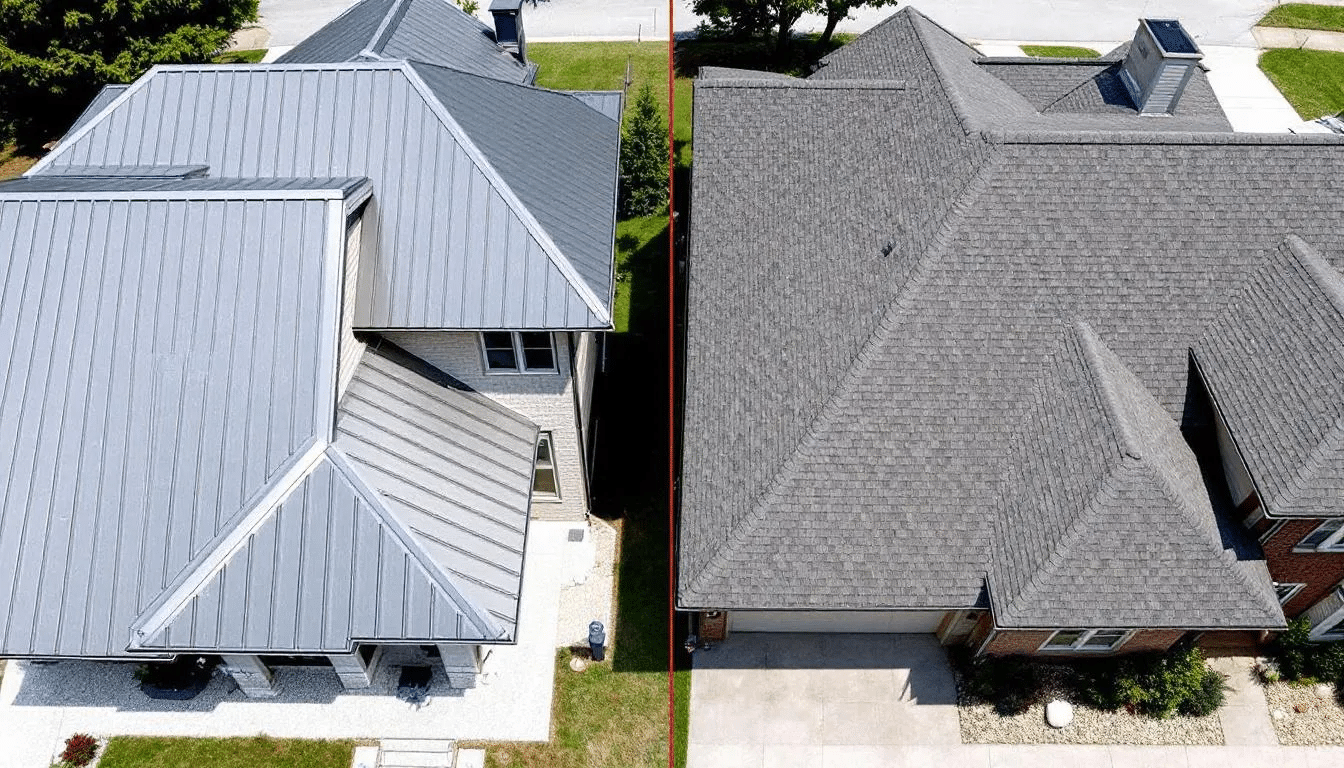
Making Your Final Decision
The choice between metal roof vs shingles ultimately depends on aligning material characteristics with your specific priorities, circumstances, and long-term goals. Homeowners focused on minimizing lifetime costs, maximizing weather protection, and reducing environmental impact will find metal roofing delivers superior value despite higher upfront investment. Those prioritizing immediate affordability, installation simplicity, and traditional aesthetics may find asphalt shingles better suit their needs.
Climate considerations should heavily influence your decision, particularly in regions prone to extreme weather events. The superior performance of metal roofing in fire, wind, and hail resistance makes it increasingly essential in high-risk areas. However, moderate climates may allow either material to perform adequately, shifting the decision toward other factors like budget and aesthetics.
Before making your final choice, obtain detailed quotes from licensed contractors experienced with your preferred material. Request references from recent projects and verify proper licensing and insurance coverage. The quality of installation significantly impacts long-term performance for both roofing materials, making contractor selection as important as material choice.
Consider the total cost of ownership rather than just initial installation expenses. Factor in expected replacement intervals, maintenance requirements, energy savings potential, and insurance implications when comparing options. This comprehensive analysis often reveals different conclusions than simple upfront cost comparisons.
Remember that roofing material selection represents a long-term investment in your home’s protection and value. Take time to research options thoroughly, consult with multiple contractors, and verify compliance with local codes and HOA requirements. The right choice depends on your unique situation, but understanding the characteristics and trade-offs of each material ensures you make an informed decision that serves your needs for years to come.
Contents
- Choose the Right Roofing Material for Your Needs
- What Makes These Roofing Materials Unique?
- Metal Roof vs Shingles: Direct Performance Comparison
- Cost Analysis: Initial Investment vs Long-Term Value
- Key Factors to Consider for Your Decision
- Which Roofing Material is Right for You?
- Making Your Final Decision

